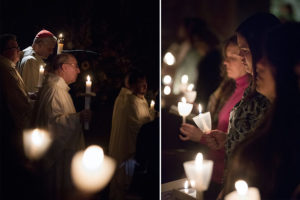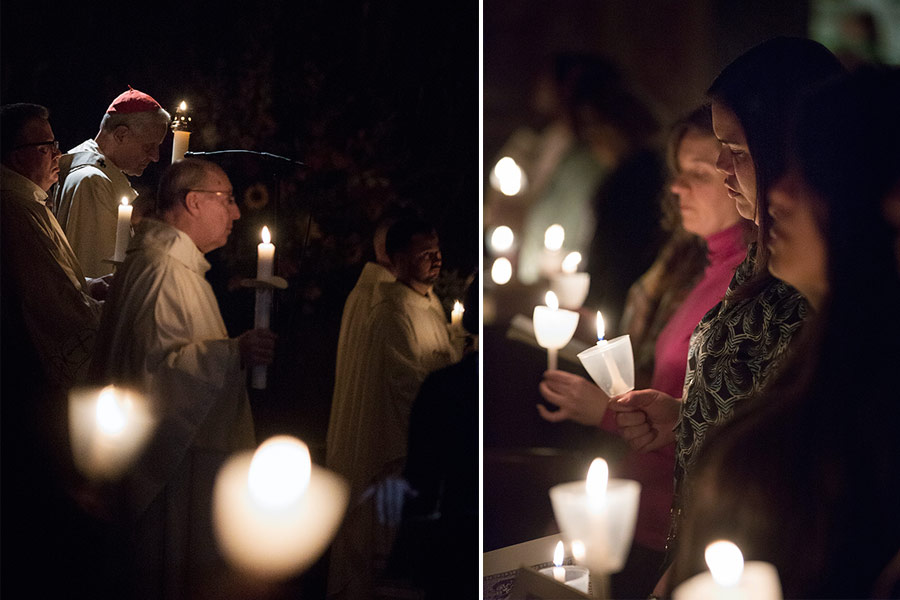
Many of you have likely read the classic description of the Church from the 1951 novel Dan England and the Noonday Devil, by Myles Connolly. It is a wonderful reminder that the Church is not an institution, but a Body, made up of members who, each in his own unique way, give witness to the one Body, which is Christ. Here is an excerpt from the book:
The Church to me is all important things everywhere. It is authority and guidance. It is love and inspiration. It is hope and assurance. It is God the Father, God the Son, and God the Holy Spirit. It is our Lady and St. Joseph. It is St. Peter and Pius XII. It is the bishop and the pastor. It is the catechism and it is our mother leaning over the crib teaching us our evening prayers. It is the cathedral at Chartres and the cross-tipped hut on Ulithi. It is the martyrs in the Colosseum and the martyrs in Uganda, the martyrs at Tyburn and the martyrs at Nagasaki. It is the wrinkled old nun and the eager-eyed postulant. It is the radiant face of the young priest saying his first Mass, and the sleepy boy acolyte with his soiled white sneakers showing under his black cassock….
It is the spire glimpsed from a train window and the cruciform miniature of a church seen far below on the earth from an airplane. It is six o’clock Mass with its handful of unknown saints at the communion rail in the gray dark and it is pontifical High Mass with its crowds and glowing grandeur in St. Peter’s….It is the Sistine Choir and it is the May procession of Chinese children singing the Regina Coeli in Peking.
It is the Carthusian at prime on Monte Allegro and the Jesuit teaching epistemology in Tokyo. It is the Scheutveld Father fighting sleeping sickness in the Congo and the Redemptorist fighting prejudice in Vermont. It is the Benedictine, the Augustinian, the Passionist, the Dominican, the Franciscan. It is all religious and especially the great unnamed Order of the Parish Priest.
It is the Carmelite Sister lighting the tapers for vespers in the drear cold of Iceland and the Sister of Notre Dame de Namur making veils for First Communion in Kwango. It is the Vincentian Sister nursing a Negro Baptist dying of cancer in Alabama and the Maryknoll Sister facing a Communist commissar in Manchuria. It is the White Sister teaching the Arabs carpetmaking in the Sahara and the Good Shepherd Sister in St. Louis giving sanctuary to a derelict child, a home to a lamb who was lost. It is the Little Sister of the Poor salving the sores of a forgotten old man in Marseilles, the Grey Sister serving the destitute in Haiti, the Blessed Sacrament Sister helping a young Negro write poetry in New Orleans. It is the Sister of Charity… It is all the Sisters everywhere.
It is the crippled woman who keeps fresh flowers before our Lady’s altar and the young woman catechist who teaches the barefooted neophytes in the distant hills. It is the girl who gives up her bridge game to drive the Sisters to the prisons and the homes of the poor, and it is the woman who goes from door to door begging for help for the orphanage. It is the proud mother of the priest and the heartbroken mother of the criminal. It is all mothers and sisters everywhere who weep and suffer and pray that sons and brothers may keep the Faith.
….It is the bad sermon and the good, the false vocation and the true. It is the tall young man who says the Stations of the Cross every evening and it is the father of ten who wheels the sick to Mass every Sunday morning at the County Hospital.
It is St. Martin and Martin de Porres, St. Augustine and St. Phocas, Gregory the Great and Gregory Thaumaturgus, St. Ambrose and Charles de Foucauld, St. Ignatius and Ignatius the Martyr, St. Thomas More and St. Barnabas. It is St. Teresa and St. Philomena, Joan of Arc and St. Winefride, St. Agnes and St. Mary Euphrasia. It is all the saints, ancient and new, named and unnamed, and all the sinners.
It is the bursting out of the Gloria on Holy Saturday and the dim crib at dawn Mass on Christmas. It is the rose vestments on Laetare Sunday and the blue overalls of the priest working with the laborers in a mine in the Ruhr.
It is the shiny, new shoes and reverent faces of the June bride and groom kneeling before the white-flowered altar at nuptial Mass, and it is the pale, troubled young mother at the baptismal font, her joy mingled with distress as she watches her first-born wail its protest against the sacramental water. It is the long, shadowy, uneven line of penitents waiting outside the confessional in the dusk of a wintry afternoon, each separate and solemnly alone with his sins, and it is the stooped figure of a priest, silhouetted against the headlights of a police car in the darkness of the highway as he says the last prayers over a broken body lying on the pavement beside a shattered automobile.
It is the Magnificat and it is grace before meals. It is the worn missal and the chipped statue of St. Anthony, the poor box and the cracked church bell. It is peace and truth and salvation. It is the Door through which I entered into the Faith and the Door through which I shall leave, please God, for eternity.
So there it is: The Church. Somewhere in this picture is you, sharing your gift and serving in your role. The Church is Christ. And all of us who are baptized are baptized into Christ, members of His Body.
Somehow I sense the rhythm of a Bach fugue as I read the description above. You probably think I’m stretching things, but consider this:
In the video below, an organist plays Bach’s Fugue in C Major. As with any musical fugue, the organist begins by announcing the theme, playing it with his right hand. Soon enough the left hand answers and eventually the feet play the theme in the pedal. The fugue then takes the theme through a series of mathematical progressions. Eighth notes become 16th notes and then even 32nd notes, but the basic theme is always being developed.
Now think of the organist as Christ, the Head of the Body, and the organ as the Body of Christ. The organ, like any body, has many parts. Because the purpose of an organ is to make sounds, the different pipes are used to make different sounds. There are diapasons, the reeds, the flutes, and the string pipes. The reeds are made up of various sounds like the trumpet, oboe, and vox humana. The string pipes make different sounds as well, such as viola, salicional, and dulciana. The flutes also come in many varieties as do the diapasons. There are wonderful mixtures that give brightness. The deep, low notes of the pedal, sometimes as low as the 32′ contra Bombarde, make the whole building shake. This, too, is an image of the Church. Christ is able to make beautiful music with this wonderful variety.
How does Jesus make this music? Like an organist playing a fugue, Jesus announces the basic theme that underlies every other aspect of the song. This theme is the truth of the Gospel. Every voice of the Church takes up that theme and sings it out in its own sound, using its own gift—but it is Christ who plays. Jesus expands and enriches the theme in a kind of development of doctrine that He leads the Church to proclaim. Rich diverse sounds develop and build thematically, but there is always the basic theme, the fundamental truth.
Yes, here is an image of the Church in a Bach fugue and in a virtuoso organist making beautiful music through unity with a wondrous instrument.


I love this so much!!! Thank you.
How beautiful is this description of the church! – and, as a musician myself, I fully appreciate your lovely analogy, Fr Charles, of Jesus Christ being the person who, in my case, uses my fingers and presses them down on my violin fingerboard, so that I (hopefully!) produce beautiful and coherent music, leading the hearer to deeper communion with the whole composition – the Kingdom of God!
I also really love this book – Myles Connolly’s ‘Dan England’ is a merry, generous and kind man, whose occupation in life is the forging of friendships and the spreading of joy. He is beset by all kinds of doubts and fears himself, but – believes totally in the ability of his friends to reach the heights of sainthood through the performance of simple acts of kindness and service in God’s Holy name. Like Msgr Charles, I thoroughly recommend this great piece of literature.
One of my favourite ‘other’ quotes on this same theme comes from the great hymn writer and convert Catholic priest, Fr Frederick William Faber:
“Love’s secret is always to be doing things for God – and not to mind they are such ‘little’ ones!”
Sounds like a ‘Dan England’ character to me!!
What was that super line from the movie, ‘Evan Almighty’? The ‘A.R.K.’ he’s building at God’s command stands for, ‘Acts of Random Kindness’, which will rescue us from the flood we find ourselves in and take us to safe, dry land; God’s Kingdom in Heaven!
God bless all . . . . . .
Delightful! Glory be and may God bless our good Msgr Pope and his readers.
I have long felt that one could see God through the warp and weave of a Bach fugue. I never thought of the fugue as being the image of the Church, but I suppose it must be.
Nice thought.
PS – I note your little arithmetic puzzle in the CAPTCHA. Are we to give the true answer or the Marxist answer (ie – ‘2 + 2 = 5’)?
Just joking – T
John XXIII said similar things. See this article in this month’s Adoremus Bulletin:
https://adoremus.org/2017/07/05/pope-john-xxiiis-quiet-theology-noble-pipe-organ-resounds-liturgical-implications/